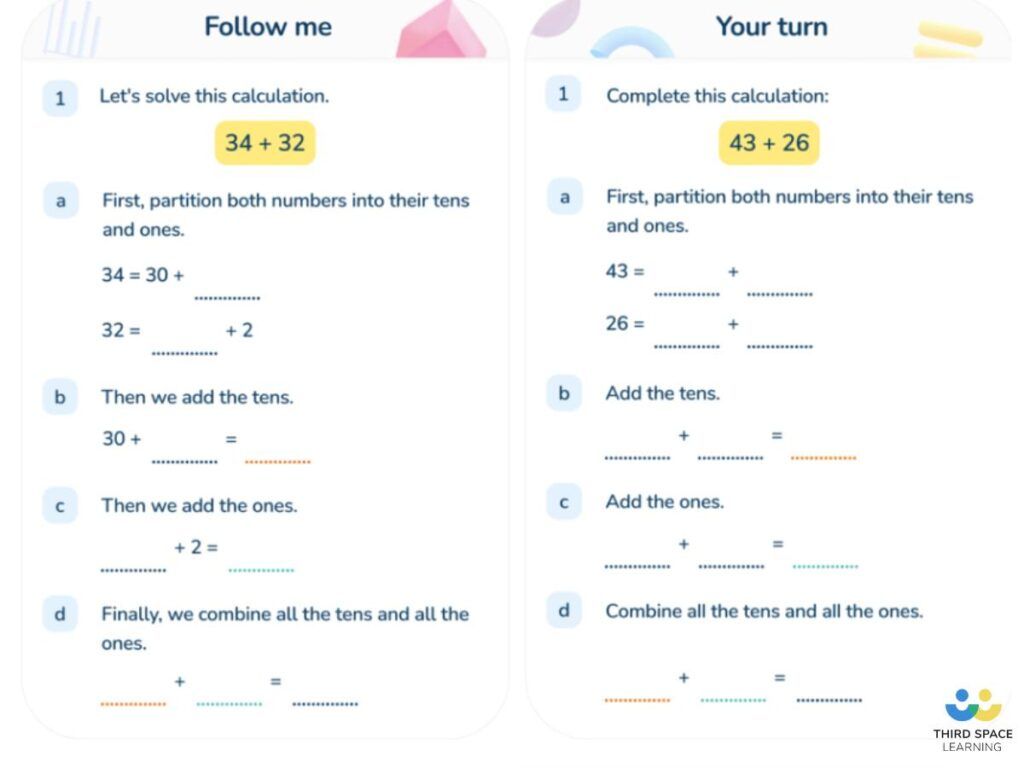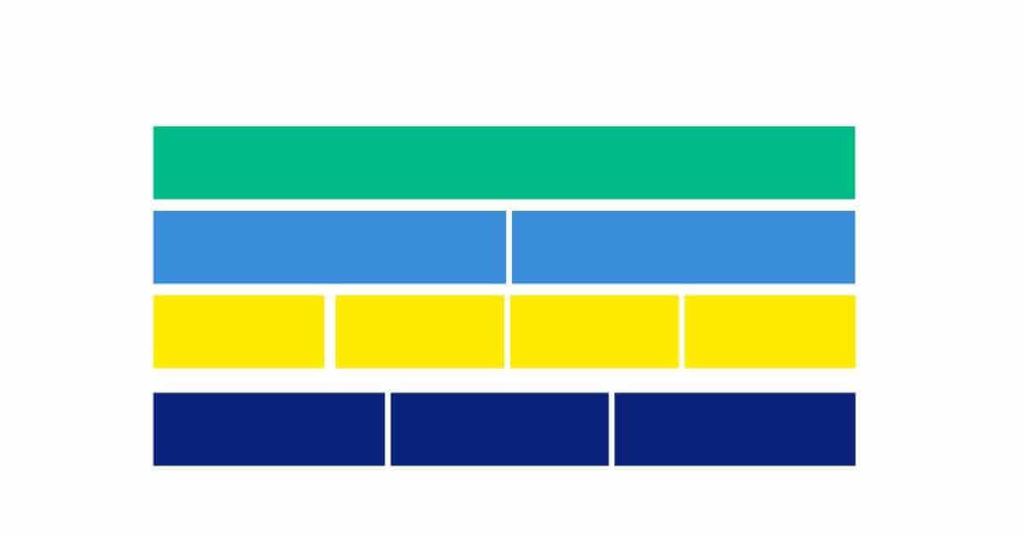Teaching 2nd Grade Mental Math: Expanding and Applying Number Facts
Second grade mental math will continue to consolidate and build on number facts learned in earlier years. As children enter 2nd grade math they should already have some secure mental math skills which they can apply to simple math problems.
Understanding of place value becomes increasingly important as 2nd grade students are expecting to manipulate bigger numbers in mental math and apply their known number bond facts to more complex problems involving 3 digit numbers.
2nd grade children will continue using two of the four number operations – addition and subtraction– and applying them, including working out which operation to use in missing number/operation problems.
What the curriculum says about 2nd grade mental math
According to the Common Core Math State Standards, students will “…use their understanding of addition to develop fluency with addition and subtraction within 100.
They select and accurately apply methods that are appropriate for the context and the numbers involved to mentally calculate sums and differences for numbers with only tens or only hundreds.”
Students should be taught to add and subtract numbers mentally, including: a three-digit number and ones; a three-digit number and tens; and a three-digit number and hundreds.
They will also be learning more multiplication tables. Some of these multiplication facts will also start to be used in division and an understanding of basic fractions.
Recommended mental math skills to teach in 2nd grade
Children should be able to answer the following 2nd grade mental math questions:
- Fluently add and subtract within 20
- All sums of two one-digit numbers
- Addition and subtraction of multiples of 10 where the answer is between 0 and 100 (e.g. 70 + 30 = 100, 20 + 40 = 60)
- Double and halves of multiples of 10 to 100 (e.g. double 60 = 120)
2nd grade mental math: place value
Understanding place value in elementary is vital and helps children to really understand numbers and mathematical facts.
For some children it may take a while for the understanding to “click” into place and manipulatives can help a lot with this. Our place value accordion, for example, is free to download, easy for children to make for themselves and effective in demonstrating place value.
Teaching resources such as these can help to visualize the numbers in multiple ways and this will support children of all abilities when it comes to the rapid recall needed when applying to problem solving.
Place value games can also be used to revisit the topic without it seeming like a chore. Repetition is an effective way of making sure knowledge is embedded.
2nd grade mental math: addition and subtraction
Addition and subtraction happens naturally for children to an extent as they will learn even as toddlers that they want “more” i.e. one more sweet after dinner. They also learn what happens when toys are “taken away” from them.
In kindergarten and 1st grade they will have built on these rudimentary understandings of the principles of addition and subtraction to apply this to multiple contexts.
In 2nd grade they will be introduced to more formal written methods, for adding to 3 digit numbers, for example, so their mental math strategies will also help them when checking their answers.

2nd grade mental math: fractions, percentages and decimals
Fractions in elementary usually start with physical objects. You may use Cuisenaire rods to show how one 10 is split into 10 equal parts. Early examples may also include cutting paper plates into fractions, to mimic cutting a pizza or cake.

It is vital that they understand the importance of equal sharing – and for this sharing of a cake is a good example. While students are not formally introduced to fractions until 3rd grade, students will partition circles and rectangles into two, three, or four equal shares, describe the shares using the words halves, thirds, half of, a third of, etc., and describe the whole as two halves, three thirds, four fourths.
Children do not yet need to tackle decimals and percentages but a solid understanding of fractions in 2nd grade will help them to more quickly understand how this later relates to decimals and percentages.
The importance of mental math skills in 2nd grade problem solving
Formal mental math tests may not be used a lot yet in all schools. However, concepts learned in 2nd grade math will form the foundation for the end of elementary school math tests, as well as prepare children for middle school math expectations.
In 2nd grade, students are tackling 2-step math word problems and applying their mental math skills to help to solve them. Mental math will help them to a) answer questions quickly and b) show them how those mental math skills apply to real life situations.
Without the math understanding and solid skills children may struggle to understand what the problem is asking of them. If they lack, for example, the knowledge of multiplication tables and how that relates to division, then they may struggle to answer a question which asks them to share sweets between friends. They will also find it harder to check that their answer is accurate.
2nd grade mental math challenges
In 2nd grade any mental math challenges should aim to build on, and extend the secured number facts across addition and subtraction. However, we should bear in mind that children may not be fluent readers yet and must therefore make sure that reading level does not impede their progression in math.
Including visuals such as pictures, or using manipulatives such as base 10 or Cuisenaire rods, will help to ensure no child is hindered in math by their reading skills. Consider verbal challenges given during whole class carpet sessions, or as part of working with a group.
In 2nd grade you will hope to see children noticing patterns and making links in their learning. Math challenges with number sequences are great for helping them with multiplication tables in third grade, as well as known numbers bonds.
As a quick start to each math lesson, put a sequence on the board with a missing number and they can start to solve that as they get settled in for the lesson. Ask them to suggest what the missing number is and ask other children to check if they are right, and test out the “theory” of their answer – this also starts to embed the methods of checking and proving their mathematical reasoning.
As they get confident you can start to increase the difficulty of the sequence and leave more than 1 number missing. You might also want to experiment with shape sequences, and then move to have shapes with different shaded fractions to increase difficulty.
Math activities and games may also form part of your repertoire of math challenges to test and encourage recall of known facts. Quizzes which are more “fun” versions of mental math tests can also help to give the right level of challenge, although you may wish to consider the level of support available if giving the same quiz to the whole class.
2nd grade mental math resources
Third Space Learning provides a wide variety of math resources, including mental math worksheets, mental math games, test questions and question powerpoints for every grade level.
A plethora of free teaching resources are also available. Check out some of our most popular resources and expand your class’ mental math skills:
Do you have students who need extra support in math?
Give your students more opportunities to consolidate learning and practice skills through personalized math tutoring with their own dedicated online math tutor.
Each student receives differentiated instruction designed to close their individual learning gaps, and scaffolded learning ensures every student learns at the right pace. Lessons are aligned with your state’s standards and assessments, plus you’ll receive regular reports every step of the way.
Personalized one-on-one math tutoring programs are available for:
– 2nd grade tutoring
– 3rd grade tutoring
– 4th grade tutoring
– 5th grade tutoring
– 6th grade tutoring
– 7th grade tutoring
– 8th grade tutoring
Why not learn more about how it works?
The content in this article was originally written by an EdTech consultant and multi-award-winning former primary teacher Jodie Lopez and has since been revised and adapted for US schools by elementary math teacher Christi Kulesza.
